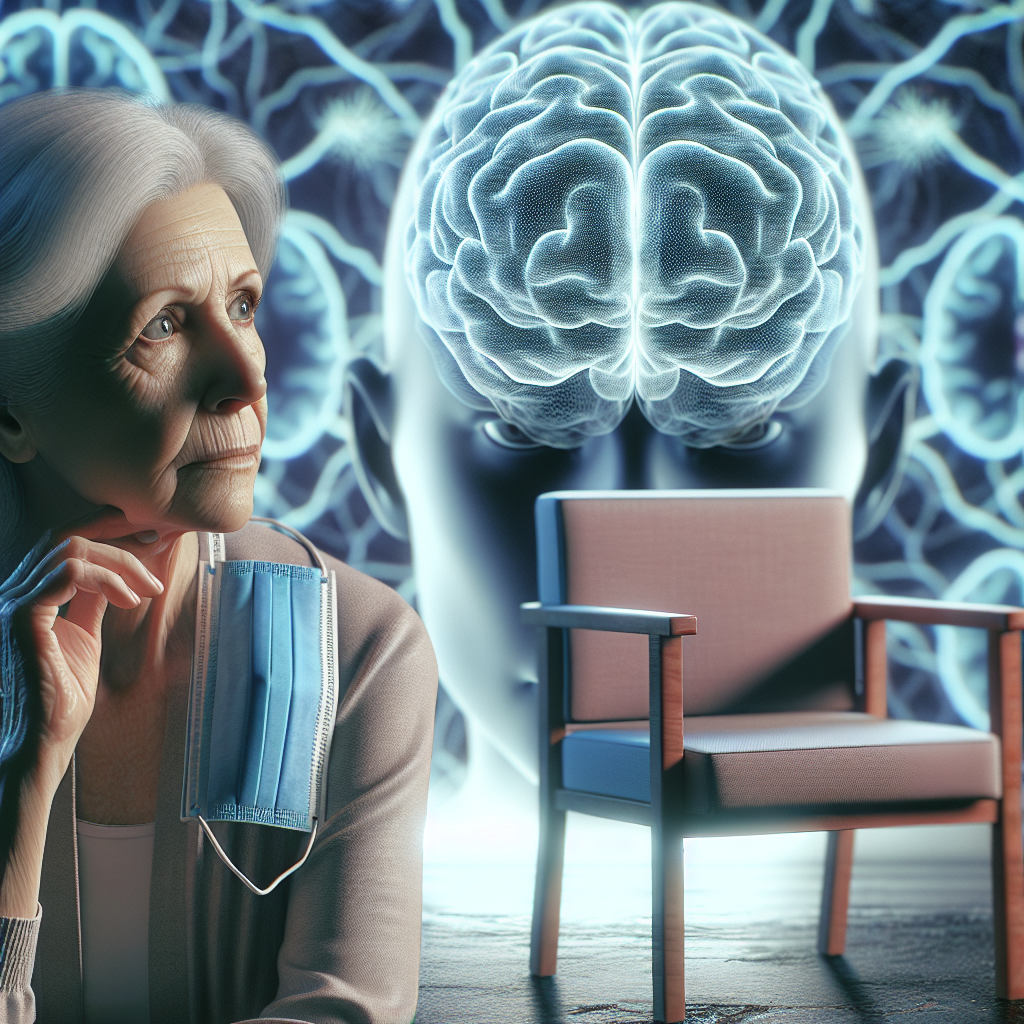Emerging research reveals that the COVID-19 pandemic may have indirectly aged our brains, even without infection. This article explores how stress, isolation, and disruption may have accelerated brain aging, particularly affecting older adults, men, and disadvantaged groups.
How Lockdowns Accelerated Brain Aging
The lockdowns imposed during the pandemic catalyzed numerous lifestyle changes. These changes were not limited to our environments but extended deeply into our mental processes, impacting the brain’s aging process. Factors like stress, isolation, and routine disruption played significant roles in accelerating brain aging during this period. Understanding this acceleration is crucial to addressing the long-term effects on mental health and cognition.
Prolonged stress is a recognized factor in brain aging. During lockdowns, individuals faced a constant stream of stressful stimuli. These ranged from health concerns to financial uncertainties and a lack of social interaction. Stress triggers the release of cortisol, a hormone that, when chronically elevated, can damage the brain’s structure and function. Cortisol is associated with memory impairment and has damaging effects on areas like the hippocampus, which is critical for learning and memory.
Isolation added another layer of complexity to the pandemic experience. Humans are inherently social creatures, and isolation can lead to profound changes in brain processes. Social isolation during lockdowns often resulted in increased levels of loneliness and depression. In turn, these emotional states can further exacerbate cognitive decline. Studies have shown that loneliness is closely linked with elevated inflammation in the brain and body. This inflammation can contribute to neurodegenerative changes and is recognized as a factor in early cognitive decline.
Moreover, the disruption of daily routines disrupted our brain’s normal processing patterns. Without the usual structure of daily activities, many people experienced a breakdown in cognitive functions. Routine offers predictability, reducing the cognitive load required to make decisions. When these routines were disrupted, individuals had to reallocate mental resources, often in high-stress environments, which overtaxed their cognitive systems. This overuse can tire the brain, reducing its efficiency and accelerating aging.
Remote living brought its challenges and intensified the issues of stress and isolation. Many found that the blending of work and home life blurred boundaries, leading to increased stress levels. The absence of distinct demarcations between work and personal time added to cognitive overload. Experiences such as ‘Zoom fatigue’ emerged as a new stressor, as constant bouts of video conferencing placed demands on our cognitive faculties not seen in typical face-to-face interactions.
Additionally, these psychological impacts transformed how the brain responded. The persistent stress and pressure changed neurotransmitter patterns, potentially speeding up brain aging. The pandemic exposed minds to abnormal levels of negative stimuli with insufficient positive counterbalance. This imbalance may have set the stage for some to experience cognitive decline sooner than expected.
Even those looking to maintain a semblance of normalcy found it challenging. Coping mechanisms, like turning to technology for social interaction, did not wholly mitigate the effects of physical isolation. While virtual interactions provided some relief, they lack the depth and context of face-to-face interactions, adding to the emotional stress and furthering cognitive degradation.
As we analyze the pandemic’s toll on mental health, it’s crucial to consider the compounded effects of these factors. The accelerated cognitive aging seen during the freeze of normal operations will require targeted interventions to reverse. The pandemic tested resilience, revealing vulnerabilities in how stressors are managed at both individual and societal levels.
Given the conditions of remote living, there’s a need to better understand the psychological constructs and their implications on cognitive health. The lessons learned point toward the necessity of developing supportive structures to buffer such stressors if a similar situation arises in the future.
Research suggests that constant exposure to stressful environments taxes cognitive reserves. Over time, this taxation can deplete the very systems that maintain cognitive health. Such depletion is akin to wearing out a machine by running it constantly without rest or proper maintenance. Indeed, we have learned from other studies how environmental stress impacts brain health similarly. For example, in contexts like adolescence, where mental processes are still developing, stress can cause long-term cognitive ramifications. Similar principles seem to apply when considering lockdown-induced stress on adult brains.
To further the understanding of this phenomenon, insights from studies on adult brain neurogenesis might lend perspective. Adult brains have the capacity to generate new neurons, particularly in stress-sensitive regions. However, chronic stress, as seen during the pandemic, can hinder this neurogenesis process, underscoring how pervasive the effects of lockdown have been.
Ultimately, the pandemic’s bout of stress, isolation, and routine disruption has spotlighted the brain’s vulnerability. It has highlighted the need for resilience-building practices and supports that could prevent such accelerated aging. The next chapter will delve into the potential for reversing these effects, exploring how lifestyle changes and mental health interventions could promote recovery and perhaps rejuvenation of cognitive functions.
Potential for Reversibility
The pandemic has left an indelible mark on our lives, not only reshaping the way we interact but affecting our cognitive health as well. Yet, there’s a silver lining: the potential for reversing the brain aging effects linked to lockdowns and pandemic-induced stresses. Multiple avenues provide hope, from lifestyle adaptations and mental health interventions to capitalizing on neuroplasticity—our brain’s inherent ability to adapt and change.
**Lifestyle Changes**
Harnessing lifestyle changes is a promising start. Exercise, nutrition, and sleep play pivotal roles in maintaining cognitive health. Regular physical activity increases blood flow, boosting brain health and memory retention. Aerobic exercises, like walking or cycling, stimulate the production of neurotrophic factors, which support neuron growth and connectivity.
Nutrition is equally critical. Diets rich in antioxidants and omega-3 fatty acids have a protective effect on the brain. Foods like berries, nuts, and fish contribute to cognitive sharpness by combating oxidative stress—a process that can accelerate brain aging. Adequate hydration remains essential, influencing cognitive tasks, mood, and alertness.
Sleep, often overlooked, is vital for mental acuity. Quality sleep empowers the brain’s natural detoxification processes, regulates mood, and consolidates memories. Establishing a routine—consistent sleep times and a peaceful environment—magnifies these benefits, counteracting some cognitive decline effects noted during the pandemic.
**Mental Health Interventions**
Addressing mental health issues swiftly improves cognitive function. Stress and anxiety are known accelerants of brain aging, undermining focus, and memory. Techniques like mindfulness and meditation are powerful tools for stress reduction. These practices bolster emotional regulation and enhance attention, providing short-term relief and long-term brain health benefits.
Therapeutic interventions extend beyond individual practices. Professional counseling or therapy can address the psychological impacts of the pandemic, from isolation to grief. Cognitive-behavioral therapy (CBT) specifically targets negative thought patterns and behaviors, fostering resilience and improved cognitive outcomes.
Community support should not be underestimated. Social interactions stimulate brain processes, creating protective effects against cognitive decline. Building environments—virtual or in-person—which nurture social connections, can mitigate the aging effects accelerated by isolation.
**Neuroplasticity and Cognitive Rehabilitation**
Neuroplasticity offers a ray of optimism. Our brains possess an extraordinary capacity to rewire, heal, and form new neural pathways. Cognitive training, through activities like puzzles or learning new languages, harnesses this adaptability. These resilient and engaging activities significantly enhance cognitive flexibility and problem-solving skills.
Brain-training applications, although needing more robust scientific validation, offer promising foundations for cognitive maintenance. These games encourage users to develop skills like memory recall and attention, which are integral territories affected by accelerated brain aging.
Research has continually pointed out the role of focused, consistent practice in cognitive rehabilitation. Engaging in these training exercises for as little as 15 minutes daily shows measurable brain improvement, illustrating the power of incremental progress.
**Research Suggestions and Future Directions**
While current avenues demonstrate promise, more research is essential to fully decipher and reverse pandemic-related age-associated cognitive decline. Longitudinal studies exploring the biological underpinnings of brain aging could provide insights into targeted interventions.
Neuroscientific advancements, including mapping brain activity through imaging technologies, unlock deeper understandings of cognitive changes and the efficacy of various interventions. Encouraging collaborative projects between neuroscientists, psychologists, and healthcare professionals could yield comprehensive strategies for cognitive recovery.
**Prioritizing Mental Health**
With the global shift towards resolving pandemic-induced challenges, addressing mental health is more paramount than ever. Cognitive well-being should be at the forefront of public health initiatives, dovetailing with the physical health strategies already implemented.
Individuals should be empowered through educational campaigns on the significance of brain health, prioritizing mental wellness, and understanding the impact of stress and isolation. Knowledge dissemination about self-care strategies could lead to widespread adoption of brain-healthy habits.
Investing in community mental health resources and support systems is critical. Online platforms have emerged as powerful connectors during the pandemic, providing continuity in support and fostering community resilience. Innovative solutions, stemming from these digital platforms, could play a pivotal role in ensuring everyone has access to cognitive health resources.
**Resources and Further Reading**
Readers looking for more information on sustaining cognitive health can explore discussions on topics like adult brain neurogenesis, which delve into how our brains continue to create new neurons, offering insights into recovering from age-related mental decline.
By understanding and implementing strategies for brain health, we can aspire to mitigate the long-term cognitive effects of the pandemic. Prioritizing mental well-being goes beyond pandemic recovery—it’s a lifelong pursuit of enhancing our cognitive resilience against future challenges.
Implications for Future Wellness
The pandemic has subtly imprinted changes on our brains, urging us to reflect on potential solutions and implications for future wellness. It becomes imperative to explore the significance of public health strategies centered on mental well-being, especially in periods of global crisis where stress factors tend to magnify. The insights gained from recent findings advocate for a reevaluation and reinforcement of mental health support as part of a broader public health policy.
A nuanced understanding of mental wellness emphasizes more than just the absence of illness. It includes the active pursuit of resilience and cognitive health, which are essential in navigating life’s adversities and uncertainties. The development and implementation of public health strategies focusing on mental well-being can create societies better equipped to handle crises. These strategies must be designed not merely as a response to the pandemic’s fallouts but as integral components of long-term health planning.
Firstly, integrating mental health education in school curriculums can lay a sturdy foundation that supports cognitive well-being from an early age. Encouraging open discussions on mental health issues can demystify and destigmatize these conditions, empowering individuals to seek help proactively.
Additionally, workplaces can evolve into arenas supportive of mental health. More organizations are now recognizing the importance of mental well-being alongside physical health, establishing programs that include stress management workshops, counseling services, and wellness breaks. Such initiatives help in fostering resilient workplace environments, aiding employees in managing stress while boosting productivity.
Community-based interventions can also play a pivotal role. Local initiatives that bring people together, even if virtually, can mitigate feelings of isolation. This is especially significant given the social distancing requirements that have been a cornerstone of pandemic response strategies. Encouraging community interaction and support networks can foster a sense of belonging and mutual care, thereby enhancing collective resilience.
Moreover, promoting lifestyle changes that maintain cognitive health should be at the forefront of these strategies. Encouraging regular physical activity, a balanced diet, and adequate sleep are foundational components that support both brain health and overall well-being. Incorporating nature into daily routines, such as through urban green spaces, can provide much-needed mental relief and restore a connection with nature.
Empowering individuals with tools for self-care is also vital. Integrating mindfulness practices, meditation, and yoga into daily routines can help individuals regulate stress and improve focus, decreasing the likelihood of mental fatigue and burnout. These practices enhance individuals’ capacity to manage stress, leading to better mental health outcomes. Resources such as scientific advancements in understanding neurogenesis can further fortify these personal health practices by illustrating the potential of the adult brain to adapt and grow, even in adverse conditions.
Crucially, access to mental health care must be democratized. This involves reducing barriers to care, such as cost and availability of services, while ensuring culturally appropriate interventions are easily accessible. Telehealth has emerged as an invaluable tool in bridging these gaps and should continue to be bolstered to reach underserved populations.
To remain proactive about mental health, individuals must embrace a proactive approach to cognitive well-being by utilizing available resources that focus on building resilience and maintaining brain health. This proactive approach involves an ongoing commitment to learning about mental health, recognizing the intrinsic value of self-care, and leveraging educational materials to enhance personal mental wellness.
The pandemic has exposed weaknesses in global health systems but also revealed pathways for improvement and adaptation. We must harness these learnings to create sustainable public health strategies that are resilient to future challenges. It is through collective action and individual responsibility that mental health can be prioritized to foster healthier societies. By doing so, we enable not just the reversal or stabilization of cognitive decline, as previously explored, but also the nurturing of a mental wellness paradigm that is equipped for future adversity.
Let us commit to a journey where mental health and wellness are prioritized and woven into the fabric of society. This commitment requires embracing change, advocating for mental health inclusion in all spheres, and remaining engaged with educational resources and strategies that support a resilient and healthier future.
Final words
The pandemic has had pervasive effects on mental health, accelerating brain aging even in those never infected. However, these changes might be reversible. Understanding that brain health is influenced by our environments highlights the critical role of mental wellbeing during global disruptions.



